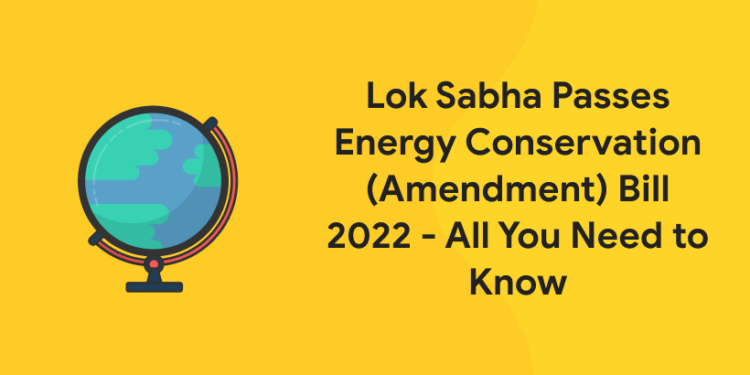Table of Contents
The Lok Sabha passed Energy Conservation (Amendment) Bill 2022 on August 9, 2022. The bill put forward a list of amendments to the Energy Conservation Act 2001 to encourage energy efficiency and conservation. The bill concentrates on energy transition, satisfying renewable energy sources and green hydrogen. It complies to the five points presented by India during the 26th Conference of Parties (CoP 26) to the United Nations Framework Convention on Climate Change Conference that happened in Glasgow in 2021.
The bill concentrates on deploying renewable energy sources, introducing the national carbon market, realising carbon trading and authorising the utilisation of non-fossil energy resources to atain decarbonisation and the Sustainable Development Goals as outlined in the Paris Agreement. It has provisions for controlling energy consumption by equipment, appliances, buildings and industries.
The bill is aimed at lessening the use of fossil fuel-based energy and promoting the use of non-fossil sources of energy. The Bill will enable the central government to use non-fossil energy sources including Green Hydrogen and Biomass Ethanol as sources of fuel to meet the energy needs of the country.
Practise free mock test and ace your government exams! Download Entri App!
The major amendments proposed are:
Mandatory utilisation of non-fossil sources of energy
Bill states the end users to meet minimal demand from fossil sources. The end users consists of the industrial sector, transport sector and commercial buildings.
Non-compliance to the obligation for utilisation of non-fossil sources of energy will attract a fine of up to Rs 10 lakh.
Carbon market
The bill enables the government to give a carbon trading scheme. The government or any authorised agency may publish carbon certificates to registered units that adhere with the scheme. The units will be allowed to purchase or sell the certificates.
Energy conservation code for large buildings
The code describes the standards for energy consumption per square metre. The new code provides standards for energy conservation, utilisation of non-conventional sources of energy and other necessities for green and sustainable buildings.
Upgradation of the scope of the Energy Conservation Building Code to residential buildings
The Energy Conservation Code under the Act prevails to commercial buildings erected after the code’s notification with a 100-kilowatt connected load or with a contractual demand of 120 kilo-volt-ampere and above.
Practise free mock test and ace your government exams! Download Entri App!
The new Energy Conservation Building Code will apply to office and residential buildings with the above specifications for commercial buildings. The bill also enables the state governments to lessen the load limit.
Extension of scope to include vehicles and vessels
The scope has been enlarged to include the Vehicles (Motor Vehicles Act 1988) and Vessels (ships and boats), according to the bill.
A fine of up to Rs 10 lakh will be imposed for not complying to standards. In the case of vessels, an additional fine of up to twice the amount of oil equivalent of energy that is consumed above the authorised level will be imposed.
In the case of the vehicle manufacturers, failure to comply to fuel consumption norms will attract a penalty of up to Rs 50,000 for each unit of the sold vehicle.
Grab Latest Study Materials! Register Here!
Revised penalty provisions by SERCs
The State Electricity Regulatory Commissions (SERC) are permitted to adjudge the penalties under the Act. The bill includes that the SERCs may also form regulations to discharge their duties.
Arrangement of members in the governing council of BEE
The Act has a provision for the formation of the Bureau of Energy Efficiency (BEE). The governing council of the BEE is constituted of members between 20 and 26, consisting of the six secretaries of departments, regulatory authorities and Bureau of Indian Standards and four members from industries and consumers.
The bill has provisions for members between 31 and 37, and the number of secretaries is increased to 12. Seven members from the industries and consumers sector will represent the council.
What are the Key Objectives of Energy Conservation (Amendment) Bill 2022?
1: Who was the first woman President of India?
The key objective of the Energy Conservation (Amendment) Bill 2022 is to lessen the country’s fossil fuel power consumption. The secondary objective is to enhance India’s Carbon market to enable trade and boost the adoption of clean technology and improvement in power efficiency.
Practise free mock test and ace your government exams! Download Entri App!
Free UPSKILLING Courses!
Take your first step toward mastering in-demand skills, acing interviews, and securing top-tier jobs with Entri's free upskilling courses.
Start Learning!Key Provisions of Energy Conservation (Amendment) Bill 2022
The key provisions of the Energy Conservation (Amendment) Bill 2022 is to allow the central government to specify norms and standards of energy efficiency. Through the bill, the central government has setup the Bureau of Energy Efficiency (BEE). In addition to this, the bill also allows the government to publish energy savings certificates and penalize consumers who make use of more energy. The bill will allow the government to penalize violations by industrial units or vessels, and manufacturers if a vehicle fails to comply with fuel consumption norms.
The key changes that have been added to the Energy Conservation (Amendment) Bill 2022 which was passed by Lok Sabha consists of the following given below:
- Mandate use of non-fossil sources, including Green Hydrogen, Green Ammonia, Biomass and Ethanol for energy and feedstock
- Setup Carbon Markets in India and set rules and provisions for Carbon Trading Scheme
- Enlarge the coverage of the Energy Conservation Regime to Large Residential Buildings
- Empower State Governments to enforce lower load thresholds
- Define scope Prescribe Consumption Standards for Energy Conservation Building Code
- Describe energy consumption standards for vehicles and vessels
- Direct and enlarge the membership of BEE Governing Council
- Enables State Electricity Regulatory Commissions for smooth discharge of its functions
Practise free mock test and ace your government exams! Download Entri App!
The Key Proposals of Energy Conservation (Amendment) Bill, 2022
- Obligation to use non-fossil sources of energy: The Act allows the central government to state energy consumption standards. The Bill adds that the government may need the designated consumers to meet a minimum share of energy consumption from non-fossil sources. Different consumption thresholds may be specified for different non-fossil sources and consumer categories. Designated consumers include: (i) industries such as mining, steel, cement, textile, chemicals, and petrochemicals, (ii) transport sector including Railways, and (iii) commercial buildings, as specified in the schedule. Negligence to meet the obligation for use of energy from non-fossil sources will be illegal with a penalty of up to Rs 10 lakh. It will also attract an additional penalty of up to twice the price of oil equal to the energy consumed above the prescribed norm.
- Carbon trading: The Bill enables the central government to specify a carbon credit trading scheme. Carbon credit mentions a tradeable permit to produce a particular amount of carbon emissions. The central government or any authorised agency may publish carbon credit certificates to entities registered under and compliant with the scheme. The entities will be entitled to buy or sell the certificate. Any other person may also buy a carbon credit certificate on a voluntary basis.
- Energy conservation code for buildings: The Act enables the central government to mention energy conservation code for buildings. The code directs energy consumption standards in terms of area. The Bill amend this to provide for an ‘energy conservation and sustainable building code’. This new code will provide norms for energy efficiency and conservation, use of renewable energy, and other requirements for green buildings.
- Applicability to residential buildings: According to this Act, the energy conservation code concerns to commercial buildings: (i) erected after the notification of the code, and (ii) having a minimum connected load of 100 kilo watts (kW) or contract load of 120 kilo volt ampere (kVA). Under the Bill, the new energy conservation and sustainable building code will also apply to the office and residential buildings meeting the above criteria. The Bill also empowers the state governments to lower the load thresholds.
- Standards for vehicles and vessels: According to the Act, the energy consumption standards may be specified for equipment and appliances which consume, generate, transmit, or supply energy. The Bill enlarges the scope to include vehicles (as defined under the Motor Vehicles Act, 1988), and vessels (includes ships and boats). The failure to comply with standards will be punishable with a penalty of up to Rs 10 lakh. Non-compliance in case of vessels will attract an additional penalty of up to twice the price of oil equivalent of energy consumed above the prescribed norm. Vehicle manufacturers in violation of fuel consumption norms will be liable to pay a penalty of up to Rs 50,000 per unit of vehicles sold.
Practise free mock test and ace your government exams! Download Entri App!
- Regulatory powers of SERCs: The Act enables the State Electricity Regulatory Commissions (SERCs) to adjudge penalties under the Act. The Bill adds that SERCs may also make regulations for discharging their functions.
- Composition of the governing council of BEE: The Act allows for the setting up of the Bureau of Energy Efficiency (BEE). The Bureau has a governing council with members between 20 and 26 in number. These include: (i) secretaries of six departments, (ii) representatives of regulatory authorities such as the Central Electricity Authority, and the Bureau of Indian Standards, and (iii) up to four members representing industries and consumers. The Bill instead provides that the number of members will be between 31 and 37. It increases the number of secretaries to 12. It also provides for up to seven members representing industries and consumers.












